Arctic -Svalbard
We are one of the pioneers in ship based exploratory tourism in the Arctic in Svalbard .We operate our voyages with small ice-strengthened vessels, whose size, capacity and capability have proven to be ideal for exploration in these remote regions. As the number of participants is limited to a small group, our expedition vessels offer a friendly, intimate atmosphere. Our ships are not luxurious cruise vessels, but accommodation and on-board life are cosy and comfortable. Our voyages are primarily defined as explorations and we spend as much time ashore as possible. We can be flexible, taking advantage of wildlife opportunities by using our zodiacs for both landings and cruises. Our knowledgeable guides assist on these outings, providing detailed information. This is supplemented by lectures on board which cover topics such as geology, wildlife and history. While cruising and hiking in the Polar regions, we are sure that you will become increasingly fascinated by these unique wildernesses, places of drama, wildlife,history and true emotion.While cruising and hiking in the Polar regions, we are sure that you will become increasingly fascinated by these unique wildernesses, places of drama, wildlife,history and true emotion.

High Lights
The Arctic, the name is derived from the Greek language and means “bear”, is indeed the home of a bear. One of the leading actors in this northern play is the Polar Bear. For many spectators, the “King of the Arctic” is the main goal of visiting this remote and wild place. But the Arctic can also boast on behalf of more great performers than just this great predator. Apart from a large number of bird species, such as Ivory Gulls, Brünnich’s Guillemots, Puffins and Little Auks, the Arctic is home to other remarkable creatures that are adapted to “life in the freezer”. In the frigid waters Belugas, Walruses and several seal species often appear, while on land Arctic Foxes and Reindeer are a fairly common sight.
The Polar world can be seen as an immense stage set in a theatre. The animals are the great actors, performing on this stage. The theatre itself is the vessel, that takes you into this dramatic world. So while traveling with us you become part of the audience - at the same time also an actor - of a great performance.The script for a play in the Polar regions includes genres such as scenery, wildlife, history and culture and offers elements like shore-based walking excursions, zodiac cruises, kayaking or even scuba diving. But, we just provides a script. The actual play and connecting plots are dominated by the settings and the actors.
The Arctic stage setting is not easily captured in a few lines. It comprises a wide range of different landscapes; rugged, barren mountains, often covered with ice and snow, exist besides miles and miles of gentle tundra, with dozens of flowering plant species in vivid colours. Steep bird cliffs with thousands of Brünnich’s Guillemots and Kittiwakes are found close to glacier fronts of blue coloured ice. These varied landscapes make the Arctic suitable joy for hiking and other more active forms of sightseeing and wildlife watching. The pack-ice of the frozen Arctic Ocean also offers the chance of spectacular cruising between ice-floes
OTL Introduction
Ship Code:OTL
|
The ice-strengthened vessel “OTL” is an excellent vessel for Polar expedition cruises in the Arctic and Antarctica, providing us with possibilities to adventure in remote locations such as the Ross Sea and Franz Josef Land. It was built in Gdynia, Poland in 1989, was named “Marina Svetaeva”, and served as a special purpose vessel for the Russian Academy of Science. The vessel is re-flagged and renamed “OTL”. The vessel has the highest ice-class notation (UL1 equivalent to 1A) and is therefore very suitable to navigate in solid one-year sea ice and loose multi-year pack ice. “OTL” is a great expedition vessel for 106 passengers with lots of open-deck spaces.The vessel is manned by 20 highly experienced international nautical crew, 19 international hotel crew, including stewardesses, 6 expedition staff (1 expedition leader and 5 guides/lecturers) and 1 doctor.
|
 |
 |
Cabin
“OTL”providing 2 restaurants ,1 bar ,1 lecture room and 1 observation lounge
4 quadruple cabins with bunk beds (these can also be used as triple or twin cabins)
2 triple porthole cabins with bunk beds (these can also be used as quads or twin cabins)
25 twin porthole cabin with 2 single lower berths
10 twin cabins with windows and 2 single lower berths
6 superior cabins with double beds and a separate day room
1 suite with a double bed and a separate day room
Remark: All cabins are spacious outside cabins with a minimum of two portholes or windows per cabin and all cabins have private shower and toilet.
Ship basic data
Length:91.25M; Beam:17.61M; Draught:5.8M; Ice Breaking:1A; Displacement:4575Ton; Speed:12Knot; Capacity:106 passengers
Images
 |
 |
|
| Restaurant |
Lecture room |
|
|
 |
 |
|
| Bar and observation lounge |
|
|
 |
 |
 |
| 4 quadruple cabins with bunk beds (these can also be used as triple or twin cabins) |
|
 |
 |
 |
| twin porthole cabin with 2 single lower berths/triple porthole cabins with bunk beds |
|
 |
 |
|
| superior cabins with double beds and a separate day room |
|
|
 |
 |
 |
| suite with a double bed and a separate day room |
|
 |
 |
| Ship layout |
|
PLA Introduction
Ship Code:PLA
|
“PlA” was built in 1976 as an oceanographic research vessel for the Royal Dutch Navy and was named “Hr. Ms. Tydeman”. The ship sailed for the Dutch Navy until June 2004 when it was purchased by us. “PlA” is a Dutch flagged completely rebuilt and converted 114-passenger vessel complies with the latest SOLAS- regulations, classed by Lloyd’s Register in London.The name “PlA” is a tribute to the predecessor(PlA Foundation, 1981-1996), the first cruise operator on a yearly base in Spitsbergen, offering voyages with a small cruise vessel named PlA. Comfortable and nicely decorated, but not luxurious. It’s made for explorers • Spacious yet small ship character, comfort & style and modern technology • Base camp for active, adventure and wildlife minded modern explorers • Small ship operation: 114 passengers in 53 passenger cabins with private facilities (toilet, sink shower)
PlA – the “base camp” for our activity program
We offers an exploratory educational travel program in the polar regions spending as much time ashore as possible. Special interest activities are available for everyone: Kayaking, Hiking, Snowshoeing, Field Camping, Ski Trekking and Zodiac Cruising. PlA is equipped with all specialist gear needed to enjoy the outdoor activities: Tents, Sleeping bags, Snowshoes, Kayaks, Rubber boots with grip sole, Outdoor jackets Etc. Giving excellent opportunities to enjoy the scenery and wildlife • Equipped with 10 Mark V inflatable zodiacs, including 40 HP 4-stroke outboard engines • 2 gangways on starboard side, that guarantees a swift zodiac operation • The ship is manned by 17 nautical crew, 19 hotel staff (6 chefs, 1 hotel manager, 1 steward-barman and 11 stewards / cabin cleaners), 8 expedition staff (1 expedition leader and 7 guides-lecturers) and 1 doctor.
|
 |
Cabin
“PLA”providing restaurant ,bar , lecture room, reading room and observation lounge
4 quadruple porthole cabins
2 triple porthole cabins
9 twin porthole cabins
26 twin cabins with window
2 twin deluxe cabins (ca. 15 m2)
10 superior cabins ca. 21 m2)
Remark:All cabins offer lower berths (either two single beds or one queen-size bed), except for the 4 quadruple cabins (2 bunk beds), and 2 triple cabins (1 bunk bed plus 1 lower bed)
Ship basic data
Length:89M; Beam:14.51M; Draught:5M; Ice Breaking:1D; Displacement:3175Ton; Speed:12Knot; Capacity:114 passengers
Images
 |
 |
 |
| Restaurant |
Lecture room |
Bars and viewing platform |
|
 |
 |
 |
| Reading room |
quadruple porthole cabins |
|
 |
 |
 |
| triple porthole cabins |
twin cabins with window |
|
|
 |
 |
| superior cabins |
|
|
 |
| Ship layout |
Around Spitsbergen – Kvitøya
| Ship code |
OTL13 |
date |
Aug 14 – Aug 24 |
| Ship code |
PLA12 |
date |
Aug 15 - Aug 25 |
| |
 |
| DAY |
ITINERARY |
FOOD |
TRANSPORT |
HOTEL |
| Day 1 |
Longyearbyen boarding
Arrive in Longyearbyen, the administrative capital of the Spitsbergen archipelago of which West Spitsbergen is the largest island. Before embarking there is an opportunity to stroll around this former mining town, whose parish church and Polar Museum are well worth visiting, while in the surrounding area of Longyearbyen. In the early evening the ship will sail out of Isfjorden. |
|
|
|
| Day 2 |
Northern Spitsbergen
On the offshore island of Ytre Norskøya, we visit a 17th century Dutch whaling site, whose large graveyard is a reminder of the hardships and dangers of life here at that time. The island’s bird life is prolific, with colonies of Little Auk, Black Guillemot, Brünnich’s Guillemot, Puffin and Arctic Skua accessible to visitors. Eastwards, we visit Raudfjord on the north coast of West Spitsbergen, a beautiful fjord dominated by spectacular glaciers and favoured by Ringed and Bearded Seal. The cliffs and shoreline of the fjord also support thriving seabird colonies. In the evening we will sail by the island of Moffen where a big herd of Walrus can be found. |
B/L/D |
|
|
| Day 3 |
Phippsøya 81 degrees north
We sail through Beverleysundet named by Parry in 1827 and also sailed by the Swedish-Russian Arc-of-Meridian Expedition in 1898. Today we will reach our northernmost point at Phippsøya, in the Seven Islands north of Nordaustlandet. Here we will be at 81 degrees north, just 540 miles from the geographic North Pole. Polar Bear inhabit this region, along with Ivory Gull. |
B/L/D |
|
|
| Day 4 |
Nordaustlandet
We push east to reach the area of Nordaustlandet, where the Nobile expedition drifted around in 1928 and where the Italian Sora tried to come to the rescue. There we hope to get to Alpinøya, reached by Sora in 1928, and then to the mouth of Finn Malmgrenfjord, and Albertinibukta and to climb Soraberget (205 M) from where we have a fantastic view on the icecap of Nordaustlandet. Alternatively we will land at Storøya, where again we may meet a group of Walrus. |
B/L/D |
|
|
| Kvitøya |
Kvitøya
Today we hope to get to the rarely visited Kvitøya farthest to the east, close to the Russian territory. The island is dominated by an icecap, which leaves a small area bare of ice and snow. We will land at the western tip at Andréneset, where the Swedish explorer André and his companions perished in 1898. We will also try to get to Kraemerpynten in the east, where an enormous group of Walrus resides. |
B/L/D |
|
|
| Day 6 |
Isisøya landing
South of Nordaustlandet we will try to land on Isisøya a Nunatak area surrounded by glaciers. Later we sail along the front of the Brasvell Glacier, the longest glacier front in Spitsbergen. In Olga Strait we have chances to spot the elusive Greenland Whale. |
B/L/D |
|
|
| Day 7 |
Nordaustlandet desert
At Vibebukta and Torrelneset, we will explore the polar desert of Nordaustlandet, next to the world’s third largest ice cap, which meets the sea nearby. We will walk along beautiful coastline covered in smooth rocks, sculpted by the surf over thousands of years. We may encounter Walrus along the way. |
B/L/D |
|
|
| Day 8 |
Barents Island
In Freemansundet we plan to land at Sundneset on the island of Barentsøya to visit an old trapper's hut and then take a brisk walk across the tundra in search of Spitsbergen Reindeer and Barnacle Goose. Later we cruise south to Diskobukta on the west side of Edgeøya. After a Zodiac cruise through the shallow bay, we land on a beach littered with whale bones and tree trunks, which have drifted here from Siberia. We can also climb to the rim of a narrow gully which is inhabited by thousands of Kittiwake, together with Black Guillemot and piratical Glaucous Gull. During the breeding season, the base of the cliffs is patrolled by Arctic Fox and Polar Bear, searching for young birds that have fallen from the nesting ledges. |
B/L/D |
|
|
| Day 9 |
Hornsund Polish research station
We start the day quietly cruising the side fjords of the spectacular Hornsund area of southern Spitsbergen, enjoying the scenery of towering mountain peaks. Hornsundtind rises to 1,431m, while Bautaen shows why early Dutch explorers gave the name ‘Spitsbergen’ - pointed mountains - to the island. There are also 14 magnificent glaciers in the area and very good chances of encounters with seals and Polar Bear. We may visit the Polish research station where the friendly staff will give us an insight into their research projects. Behind the station the mountains are home to thousands of pairs of nesting Little Auk. |
B/L/D |
|
|
| Day 10 |
Ahlstrandhalvøya Landing
Today we land on Ahlstrandhalvøya at the mouth of Van Keulenfjorden. Here piles of Beluga skeletons (the Beluga is a small white whale), the remains of 19th century slaughter, are yet another reminder of the consequences of thoughtless exploitation. Fortunately, Beluga were not hunted to the edge of extinction and may still be seen locally. Indeed, there is a good chance that we will come across a pod. Cruising into Recherchefjorden during the afternoon we can explore an area of tundra at the head of the fjord where many reindeer feed. |
B/L/D |
|
|
| Day 11 |
Longyearbyen -Oslo
Return to Longyearbyen and disembark for the transfer to the airport and the flight to Oslo and home. |
|
|
|
N.B.
The chances that we can complete a full Spitsbergen Circumnavigation (based on our experiences from 1992 until 2012) are about, 30 % in the first half of July, 60 % in the second half of July, 90% in the first half of August, 95% in the second half of August. In case we cannot complete a full circumnavigation we will mostly resort to a program in Northeast or Southeast Spitsbergen.
Other itinerary offered
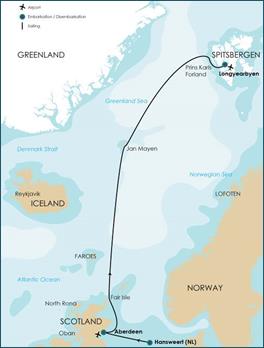 |
 |
|
South Spitsbergen – Bear Island Seals and Bears
|
North Spitsbergen Polar Bear Special
|
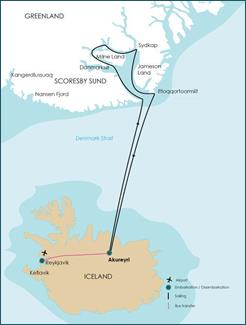 |
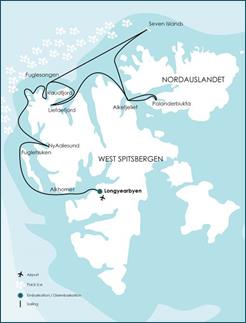 |
|
Scoresby Sund – Aurora Borealis
|
North Spitsbergen
|
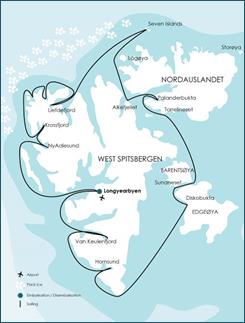 |
 |
|
Around Spitsbergen
|
North Spitsbergen Polar Bear Special
|
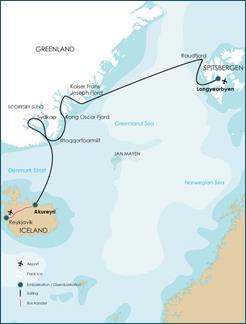 |
 |
|
Northeast Greenland
|
North Atlantic Odyssey - Whale Safari
|
Please contact us if you need more information !
|

















































